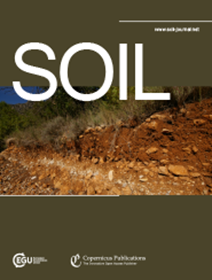Impacts of vegetation restoration on soil physicochemical properties, bacterial communities, and metabolites in newly reclaimed croplands
IF 4.3
2区 农林科学
Q1 SOIL SCIENCE
引用次数: 0
Abstract
Abstract. To find one suitable vegetation restoration type as a good means of restoring newly reclaimed croplands in subtropical of China. This study investigated the effect of vegetables, corn, and peach in soil properties, bacterial communities, and metabolites of newly reclaimed lands after three years restoration. Results from this study indicated that soil physicochemical properties were differentially affected by vegetation restoration of three different plants, while the effect depends on both the vegetation types and the kind of soil parameters. Indeed, the pH, soil bulk density (SBD), soil organic matter (SOM) and total nitrogen (TN) were generally unaffected except a significant reduction in SBD (13.97 %) and SOM (35.41 %) by vegetable and peach, respectively. However, three different plants significantly increased the available phosphorus (AP) (75.03–143.02 %), available potassium (AK) (154.90 % and 103.93 %) and microbial biomass carbon (MBC) (37.71–144.93 %), with the greatest increase by vegetable relative to the control except a significant reduction in the AK (41.73 %) by peach. Furthermore, the analysis of 16S rRNA gene high-throughput sequencing revealed that the vegetation of three plants increased the relative abundances (RAs) of soil bacterial phyla and genera with 6.21–10.54 % increase in operational taxonomic units (OTUs), 6.22–10.53 % increase in Chao1 and 2.30–3.11 % increase in Shannon indices, while redundancy discriminant analysis (RDA) revealed that the change of soil properties were highly related to the variation in bacterial community composition. In addition, 130 significantly differential metabolites (SDMs) that belong to organic acid, amino acid, heterocyclic compounds between vegetable and the control were identified based on liquid chromatography-mass spectrometry (LC-MS) analysis, while the top 20 SDMs were highly correlated with the 7 enriched bacterial genera. Overall, the results showed that the vegetation of three plants, in particular vegetable can ameliorate soil quality of newly reclaimed croplands by improving soil chemical properties, and increasing the richness and complexity of bacterial community structure, as well as specific bacterial genus and metabolites.植被恢复对新开垦农田土壤理化性质、细菌群落和代谢物的影响
摘要。寻找一种适合的植被恢复类型,作为中国亚热带新开垦农田恢复的良好手段。研究了蔬菜、玉米和桃子对新开垦土地3年后土壤性质、细菌群落和代谢物的影响。结果表明,3种不同植物植被恢复对土壤理化性质的影响存在差异,其影响既取决于植被类型,也取决于土壤参数种类。土壤pH、土壤容重(SBD)、土壤有机质(SOM)和全氮(TN)均未受影响,但蔬菜和桃子分别显著降低了SBD(13.97%)和SOM(35.41%)。3种不同植物均显著提高了速效磷(AP)(75.03 ~ 143.02%)、速效钾(AK)(154.90%和103.93%)和微生物量碳(MBC)(37.71 ~ 144.93%),其中蔬菜的速效钾(AK)(41.73%)显著低于对照,但桃子的速效钾(AK)显著高于对照。此外,16S rRNA基因高通量测序分析显示,3种植物的植被增加了土壤细菌门和属的相对丰度(RAs),其操作分类单位(OTUs)增加了6.21 - 10.54%,Chao1增加了6.22 - 10.53%,Shannon指数增加了2.30 - 3.11%,而冗余判别分析(RDA)显示土壤性质的变化与细菌群落组成的变化高度相关。此外,通过液相色谱-质谱(LC-MS)分析,鉴定出130个显著差异代谢物(SDMs)属于有机酸、氨基酸、杂环化合物,其中前20个SDMs与7个富集菌属高度相关。综上所述,以蔬菜为代表的3种植物植被可以通过改善土壤化学性质、增加细菌群落结构的丰富度和复杂性、特定细菌属和代谢物等来改善新开垦农田土壤质量。
本文章由计算机程序翻译,如有差异,请以英文原文为准。
求助全文
约1分钟内获得全文
求助全文
来源期刊

Soil
Agricultural and Biological Sciences-Soil Science
CiteScore
10.80
自引率
2.90%
发文量
44
审稿时长
30 weeks
期刊介绍:
SOIL is an international scientific journal dedicated to the publication and discussion of high-quality research in the field of soil system sciences.
SOIL is at the interface between the atmosphere, lithosphere, hydrosphere, and biosphere. SOIL publishes scientific research that contributes to understanding the soil system and its interaction with humans and the entire Earth system. The scope of the journal includes all topics that fall within the study of soil science as a discipline, with an emphasis on studies that integrate soil science with other sciences (hydrology, agronomy, socio-economics, health sciences, atmospheric sciences, etc.).
 求助内容:
求助内容: 应助结果提醒方式:
应助结果提醒方式:


